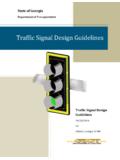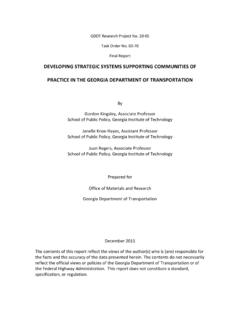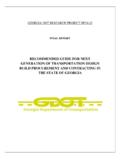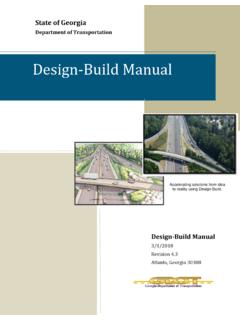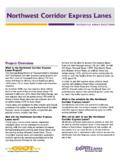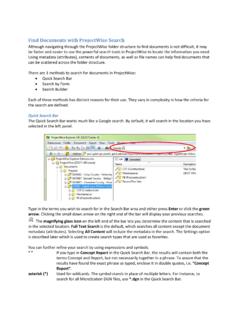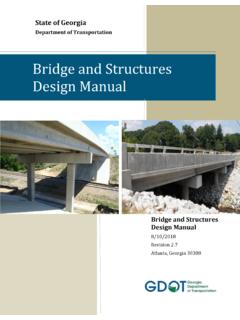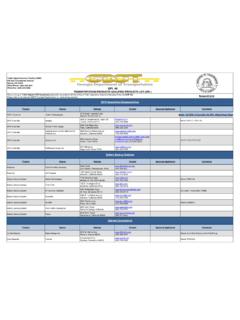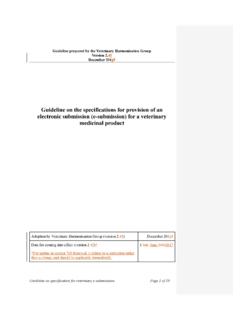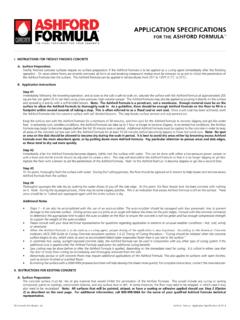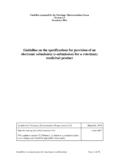Transcription of Georgia DOT Asphalt Pavement Selection Guidelines
1 Georgia DOT Asphalt Pavement Selection Guidelines Office of Materials and Research 15 Kennedy Drive Forest Park, Georgia 30297 November 2006 2 TABLE OF CONTENTS I. Scope 3 II. Traffic Levels and Classification 4 III. Materials 4 IV. Low to Medium Volume Surface Mixes 8 V. Medium to High Volume Surface Mixes 10 VI. Selection Guide 10 VII. Additional Assistance 13 3I. Scope These Guidelines present the recommended Asphalt paving practices of the Georgia Department of Transportation (GDOT).
2 They were developed in consultation with the paving and materials industries, through the Georgia Partnership for Transportation Quality. Types of Asphalt Pavement covered include Bituminous Surface Treatments (BST) and Hot Mix Asphalt (HMA) composed of the Department's , and Superpave mixes. These materials and their construction requirements are described in Sections 400, 424, 824, and 828 of the Standard Specifications, 2001 Edition, in Special Provisions 400 and 828 issued Feb. 24, 2006, and in Special Provisions 424 and 824 issued Mar. 6, 2006. The Guidelines do not address mix types for other purposes open-graded mixes (PEM and OGFC) and structural mixes (Stone Matrix Asphalt and Types 19 and 25 Superpave).
3 Likewise, different guidance may apply in paving off-road pavements such as parking areas and airport paving. Questions regarding these topics may be referred to the State Bituminous Construction Engineer at the GDOT Office of Materials and Research (see section VII). Designs and specifications should be based on a detailed assessment of each project and the availability and costs of materials. The tables in the following sections represent the applications and thicknesses normally specified, while providing flexibility to address unusual constraints and conditions. Mix types are distinguished according to nominal maximum size of the aggregate in millimeters, relates to an aggregate size of millimeters, or 3/8 inch.
4 Selection Guidelines for Asphalt Pavement presented in two categories, Low to Medium Volume and Medium to High Volume: TPD = trucks per dayADT = average daily traffic *Note: ADT is conservative and can be exceeded with accurate information on TPD Surface Mix Recommendations Volume Traffic Count Surface Type Low to Medium TPD < 100 or ADT < 800 BST TPD < 100 or ADT < 1,000* HMA TPD < 200 or ADT < 2,000* I HMA Medium to High TPD < 200 and 2,000 < ADT < 10,000 II HMA TPD > 200 or ADT > 10,000 HMA 4 Figure 1 II. Traffic levels and classification A key parameter for selecting an Asphalt Pavement alternative is Average Daily Traffic, or ADT.
5 Equally important for most roads is the number and class of trucks measured as trucks per day (TPD). Traffic information is collected annually in all Georgia counties and is available on line at: The site includes important keys to the data in the tables, such as whether the ADT is directional or two-way and whether the data is measured or estimated. TPD can be estimated using the information of road classifications. In the Selection Tables that follow, designers may select appropriate Asphalt alternatives for the full range of traffic levels and distress conditions typically encountered. In some cases, traffic data, especially truck traffic, must be estimated from available information, including site inspections and data from adjoining roads.
6 III. Materials A. Approved sources and mixtures GDOT maintains Qualified Products Lists (QPL's) of approved producers of HMA and its constituent ingredients, and these approved sources are regularly monitored and tested. In Asphalt Pavement Selection Guideline Known Traffic Level NoSee Section II ( ) Yes Low to Medium Volume Road Yes NoTable 5 ( ) Table 4 ( ) 5addition, mix designs used in state contracts must be produced by approved laboratories and reviewed by the Office of Materials and Research, as discussed in Part below. Specifying GDOT-approved mix designs ensures that the materials are of good quality and formulated correctly and that each mixture has met appropriate criteria which can be monitored for quality assurance.
7 The list of qualified HMA producers is QPL 45. Approved aggregate suppliers are listed on QPL1 and QPL2. QPL's are accessible on the Department's web site: B. Bituminous material Bituminous materials used in Georgia include Asphalt cement and cationic Asphalt emulsion. The types of bituminous material used for BST in Georgia are Asphalt cement, grades PG58-22 and PG64-22 and cationic Asphalt emulsion, grade CRS-2h. The type of bituminous material used in the production of HMA in Georgia is Asphalt cement, grades PG64-22, PG67-22 and PG76-22. PG67-22 is the most commonly used type of Asphalt cement in Georgia for HMA.
8 PG 76-22 is a polymer modified Asphalt cement and is normally used for high traffic areas. The list of qualified bituminous materials is QPL-7. The type of Asphalt binder for each mix will be included on the approved GDOT Job Mix Formula for each type of mix. Specifications for Asphalt cement are located in Section 820 of the GDOT Specifications. Specifications for cationic Asphalt emulsions are located in Section 824 of the GDOT Specifications. C. Aggregate groups Aggregates can be different sizes and from different geology. Aggregates produced in the northwest corner of Georgia consist of sedimentary rock (limestones and dolomites), which are classified as "Group I" aggregates.
9 Use of these materials as a surface course is restricted according to traffic level. Granitic aggregates, classified as "Group II", should always be specified for surface mixes for roads with the highest volume of traffic, as noted in Table 1. Limits for Group I mixes are also shown in Table 1 below. (Although hauling costs normally preclude use of Group I aggregates outside of their source areas, specifying the aggregate group is advisable, even in South Georgia .) * Group I Aggregates may be used where the Surface Treatment is to be overlaid with Asphaltic Concrete. Table 1 Aggregate Groups by Traffic Level for Surface Courses Type of Surface Course ADT Specify: Explanation Surface Treatment Less than 800 Group I or Group II 100% Group I or 100% Group II Hot Mix Asphalt Up to 800 Group I, Group II, or Blend Any group or blend Hot Mix Asphalt 800 to 4000 Blend or Group II Either Group II or blend of Groups I and II.
10 The Group I fraction should not exceed 60% by weight of the total aggregate nor more than 50% of the coarse aggregate. Hot Mix Asphalt 4000 and above Group II only 100% Group II only 6D. Recycled Asphalt Pavement (RAP) RAP is used routinely in both low-volume and high-volume mixes in Georgia . Like all materials used in GDOT-approved mixes, a contractor's RAP stockpile is tested, approved, and identified by a numerical source code. When RAP from the approved stockpile is used as an ingredient in a mix design, its source code and the percentage allowed in the mix are listed in the mix design document. E. Specifying approved ingredients and mixtures.

